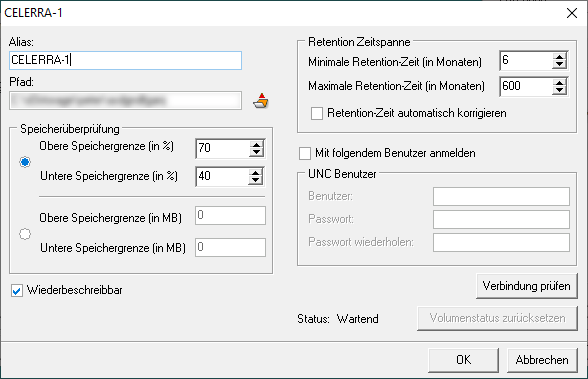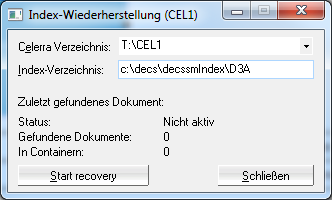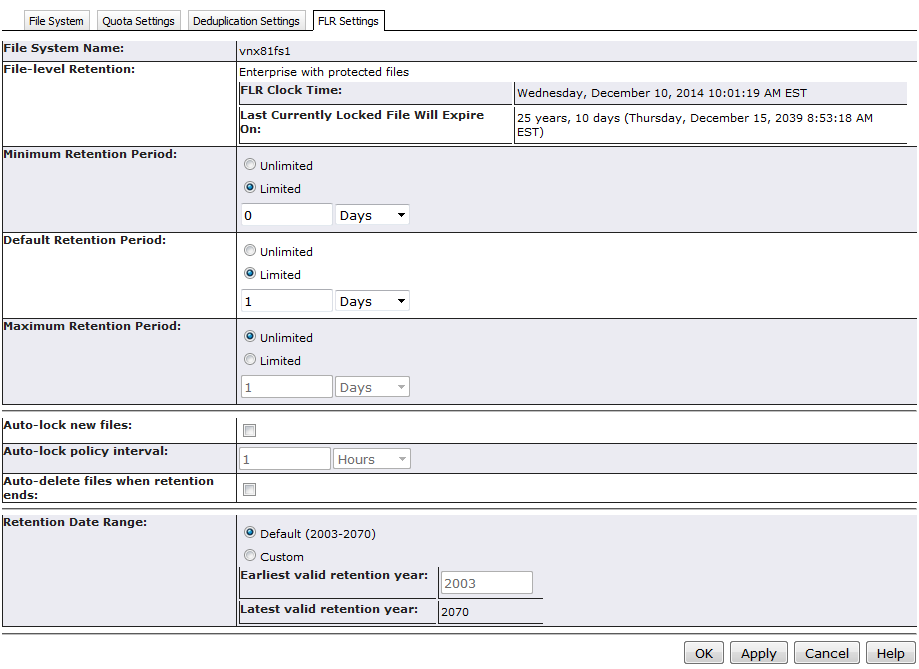d.ecs storage manager Celerra
The Celerra module allows d.ecs storage manager to store documents on a VNX system with FLR option. It supports the Filelevel Retention-technology which protect documents from being modified or deleted for a certain period of time.
Warning
In order to ensure audit-proof storage, the documents must be written to a volume protected by the "File Retention"-technology. This volume created by the Filelevel Retention option is addressed by the d.ecs storage manager via a network share.
Furthermore, a new user should be created in the Windows structure. On the side of d.ecs storage manager, this is the only user who requires the right Full Control for the VNX area on the VNX system. d.3 process manager, in which the d.ecs storage manager runs, is then started under this user.
If several users have Full Control access to the File Retention volume, it could happen that documents are incorrectly written to the VNX system and are not extended when starting the d.ecs storage manager under a different user.
If other d.3 processes run in this d.3 process manager, you must also consider the rights required by these other processes.
Warning
To store the documents with the d.ecs storage manager on an FLR protected file system, it is essential that the default, minimum, and maximum retention period for the FLR file system are set equivalent to the retention periods in the leading system (d.3/ecspand).
Configuration
The following parameters are configurable on the main tab of the system:
Objective: List of the target paths where the documents are stored and their properties.
Alias: Alias name of the volume.
Storage path: Target path where the documents are stored.
Upper storage limit: Specifies how much storage space may be used for storing data.
Rewritable: If this option is set, the data will be re-written as soon as the available storage space falls below the Lower storage limit.
Lower storage limit: Specify the percentage of disk space which may be occupied before documents can be stored again.
Volume ID: Every storage path gets a unique volume ID.
Force CAS creation: If this option is enabled, then the documents are stored in CAS containers. These containers have a unique ID which is used to verify the consistency of a document during restore. (During the retrieval it is checked, if the data in a CAS container are unchanged before a document is passed on to the d.3 server / d.3 gateway / API). Should be enabled in connection with ecspand.
Validate data: If this option is enabled, a file comparison based on the RipeMD256 mechanism is performed after having copied a file to the Celerra volume. This ensures that the file as completely transferred.
Unity mode: This switch must be enabled if the used storage system is a Unity system.
The following parameters can be configured on the HealthCheck tab:
File name for HealthCheck: File name to be used during the system check by the HealthCheck process.
Volume configuration
 |
Alias: Alias name for the volume; if a name is specified here, it is displayed instead of the volume ID in the Web interface for a better overview.
Storage path: Specify a path here where the documents are stored
Upper storage limit (in %): Here you can define a percentage of how much storage space may be used for the storage of data.
Lower storage limit (in %): Specify the percentage of hard disk space which may be occupied before documents can be stored again.
Upper storage limit (in MB): Here you can define in MB how much storage space may be used for the storage of data.
Lower storage limit (in MB): Specify the percentage of hard disk space which may be occupied before documents can be stored again.
Rewritable: This option is only available, if more than one volume is configured and specifies, if a volume should be rewritten as soon as the lower storage threshold of the volume is exceeded (e.g. by deleting old documents).
Minimum/maximum retention period (in months) Specifies the range in which the retention time passed by the delivering process may be located for a document. These values have to be set and must be equivalent to the settings of the Celerra/VNX volume.
Automatically correct retention period: If a retention-period outside the specified range is passed by a delivering process, then the time is automatically set to the minimum or maximum, if this parameter is enabled. Else the job is blocked and the document is not written to the secondary storage.
Log in with the following user: User to be used for the login to the volume.
Password/Confirm password: Password of the user to be used for the login to the volume.
Status: One of three possible values of the volume is displayed. Use the Reset volume status button to reset the status of a volume to Waiting.
Waiting: There is currently no writing on the volume.
Writing: Currently writing on the volume.
Full: The volume was written on until it exceeded the configured memory limits. The volume cannot and will no longer be written to.
Index recovery
The d.ecs storage manager Celerra module allows to recover the internal document index after a loss. For this effect, it browses the specified target directory for documents and thus rebuilds the index. This type of index recovery should only be used, if no index-recovery-files (*.IR) exist to restore the index (see also Tab: Database logging).
 |
Celerra directory: Directory on the VNX system to be searched for documents.
Index directory: Directory where the index of the documents for the VNX system is to be stored.
Preparation of the VNX volume
The volume on the VNX system must be defines as follows for d.ecs storage manager to operate with it properly:
 |